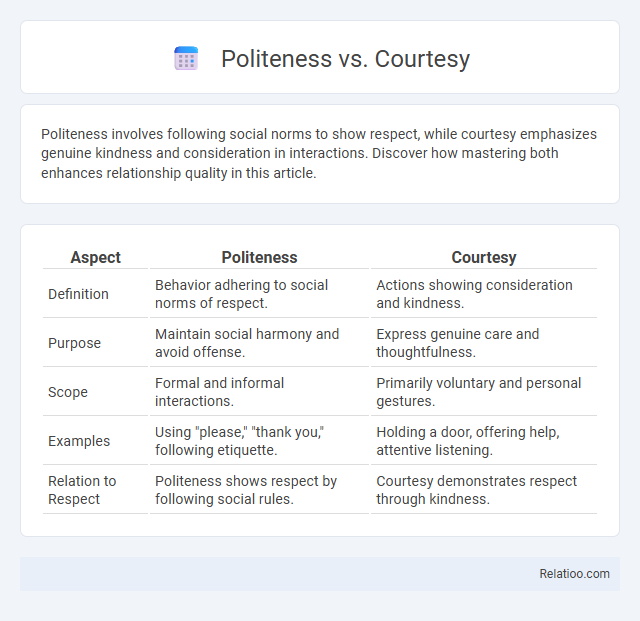Politeness involves following social norms to show respect, while courtesy emphasizes genuine kindness and consideration in interactions. Discover how mastering both enhances relationship quality in this article.
Table of Comparison
| Aspect | Politeness | Courtesy |
|---|---|---|
| Definition | Behavior adhering to social norms of respect. | Actions showing consideration and kindness. |
| Purpose | Maintain social harmony and avoid offense. | Express genuine care and thoughtfulness. |
| Scope | Formal and informal interactions. | Primarily voluntary and personal gestures. |
| Examples | Using "please," "thank you," following etiquette. | Holding a door, offering help, attentive listening. |
| Relation to Respect | Politeness shows respect by following social rules. | Courtesy demonstrates respect through kindness. |
Understanding Politeness and Courtesy
Politeness and courtesy both involve respectful behavior, but politeness focuses on socially accepted language and manners to avoid offense, while courtesy emphasizes considerate actions that show genuine kindness. Understanding politeness requires recognizing cultural norms and context-specific etiquette that guide verbal and nonverbal communication to maintain social harmony. Courtesy extends beyond speech, incorporating thoughtful gestures and attentiveness that foster positive interpersonal relationships.
Defining Politeness: Key Characteristics
Politeness is characterized by respectful and considerate behavior that adheres to social norms and cultural expectations to maintain harmony in communication. It involves using appropriate language, tone, and gestures that reflect awareness of others' feelings and social context. Your ability to demonstrate politeness fosters positive interactions and builds trust in personal and professional relationships.
What is Courtesy? Meaning and Examples
Courtesy refers to the considerate behaviors and gestures that show respect and kindness towards others, often manifested through small acts like saying "please," "thank you," or holding the door open. Unlike politeness, which involves adhering to social norms and etiquette, courtesy emphasizes genuine care and attentiveness to the feelings of those around you. Your practice of courtesy can foster positive relationships and create an environment of mutual respect and warmth.
Historical Perspectives on Politeness and Courtesy
Historical perspectives on politeness and courtesy reveal distinct social functions shaped by cultural norms and class structures. Politeness traditionally emphasized linguistic strategies to minimize social friction and maintain face, while courtesy involved ritualized behaviors demonstrating respect and deference within hierarchical societies. Understanding these historical distinctions helps you navigate modern social interactions with greater awareness of how etiquette evolved through time.
Cultural Differences in Politeness vs Courtesy
Cultural differences deeply influence how politeness and courtesy are expressed and interpreted, with politeness often reflecting social norms and hierarchical structures, while courtesy emphasizes voluntary kindness and respect. In some cultures, politeness may require formal language and indirect communication to maintain harmony, whereas courtesy involves deliberate gestures or actions that show goodwill regardless of social status. Understanding these distinctions can help you navigate cross-cultural interactions more effectively by recognizing when a behavior is driven by societal expectations versus personal respect.
The Role of Intent: Surface vs Sincere Actions
Politeness often involves socially accepted behaviors that adhere to cultural norms, while courtesy emphasizes respectful actions intended to benefit others. The role of intent distinguishes surface politeness, characterized by automatic or strategic gestures, from sincere courtesy, which reflects genuine concern and empathy. Understanding this distinction helps clarify how interactions either foster authentic social bonds or merely maintain appearances.
Impact on Communication and Relationships
Politeness, courtesy, and respect each uniquely influence communication and relationships by shaping the tone and depth of interactions. Politeness involves following social norms to avoid offense, creating a smooth and predictable dialogue flow. Courtesy reflects thoughtful behavior that fosters goodwill and strengthens trust, while respect acknowledges personal boundaries and values, deepening connection and mutual understanding in your relationships.
Politeness and Courtesy in Professional Settings
Politeness in professional settings involves using respectful language and considerate behavior to maintain positive relationships, while courtesy emphasizes specific actions such as greetings, punctuality, and attentive listening. Politeness reflects an overall attitude of respect and empathy, essential for effective communication and teamwork, whereas courtesy consists of practical expressions that reinforce that attitude. Combining politeness and courtesy fosters a professional environment conducive to collaboration, trust, and mutual respect.
Navigating Social Situations: When to Use Each
Navigating social situations effectively requires understanding the subtle differences between politeness, courtesy, and etiquette to choose the appropriate behavior for each context. Politeness involves showing respect and consideration through language and actions, while courtesy emphasizes thoughtful gestures and manners that make interactions pleasant. Your awareness of when to apply politeness, exhibit courtesy, or follow etiquette can foster positive relationships and smooth communication in both personal and professional settings.
Building Lasting Impressions Through Politeness and Courtesy
Building lasting impressions through politeness and courtesy involves consistently demonstrating respectful language and considerate behavior that acknowledges others' feelings and social norms. Politeness emphasizes adherence to societal rules of etiquette and verbal decorum, while courtesy extends to actions showing genuine kindness and attentiveness beyond mere words. Together, these qualities foster trust, enhance communication, and create positive, memorable interactions that encourage ongoing relationships.

Infographic: Politeness vs Courtesy
 relatioo.com
relatioo.com